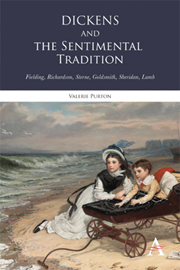Book contents
- Frontmatter
- Contents
- Acknowledgements
- A Note on the Text
- Introduction
- Chapter 1 Dickens and the Sentimentalist Tradition
- Chapter 2 Sentimentalism and its Discontents in the Eighteenth-Century Novel: Fielding, Richardson and Sterne
- Chapter 3 Sentimentalism and its Discontents in Eighteenth-Century Drama: Goldsmith and Sheridan
- Chapter 4 Dickens and Nineteenth-Century Drama
- Chapter 5 The Early Novels and The Vicar of Wakefield
- Chapter 6 The Later Novels
- Conclusion The Afterlife of Sentimentalism
- Notes
- Bibliography
- Index
Conclusion - The Afterlife of Sentimentalism
Published online by Cambridge University Press: 05 November 2012
- Frontmatter
- Contents
- Acknowledgements
- A Note on the Text
- Introduction
- Chapter 1 Dickens and the Sentimentalist Tradition
- Chapter 2 Sentimentalism and its Discontents in the Eighteenth-Century Novel: Fielding, Richardson and Sterne
- Chapter 3 Sentimentalism and its Discontents in Eighteenth-Century Drama: Goldsmith and Sheridan
- Chapter 4 Dickens and Nineteenth-Century Drama
- Chapter 5 The Early Novels and The Vicar of Wakefield
- Chapter 6 The Later Novels
- Conclusion The Afterlife of Sentimentalism
- Notes
- Bibliography
- Index
Summary
‘Who will write the history of tears?’
In Dombey and Son Dickens makes a virtue of the restrictions imposed by nineteenth-century sentimentalism, modulating them into a monument to the sentimentalist vision. This vision had evolved, as has been shown, from eighteenth-century rationalism and ‘sentiment’ as sententiousness, via the epistolary novel and the anarchic experimentations of Sterne, through sentimental comedy into the complexities of Goldsmith and Sheridan. In the move from these two dramatists to early nineteenth-century drama, dramatic complexity was lost in the rise of the ‘divided style’ of the great Victorians, involving a newly judgemental voice. It became impossible, in Charles Lamb's words, to imagine ‘a state of things for which there is neither reward not punishment’. Dickens's generation of early Victorians misread or ignored the rich ambiguities of Sterne, Goldsmith, Sheridan and even Fielding, measuring them narrowly in terms of their own ‘coxcombry of moral judgment’. This was linked with a move from many ‘implied readers’ in the audiences of Goldsmith and Sheridan, to the single, united, judgemental voice of the Victorian public, a public which Dickens went on to seduce and make his own. Thackeray – always drawn to but always suspicious of sentimentalism – exposes its artistic limits in Vanity Fair. The final revelation of Amelia's inadequacy and Dobbin's cynicism, according to Wolfgang Herrlinger, constitutes Thackeray's attempted coup de grace for sentimentalism. Dickens's Dombey and Son was serialised in 1847, at the same time as Vanity Fair, having been prompted, bizarrely, by his reading of Tristram Shandy.
- Type
- Chapter
- Information
- Dickens and the Sentimental TraditionFielding, Richardson, Sterne, Goldsmith, Sheridan, Lamb, pp. 151 - 160Publisher: Anthem PressPrint publication year: 2012



